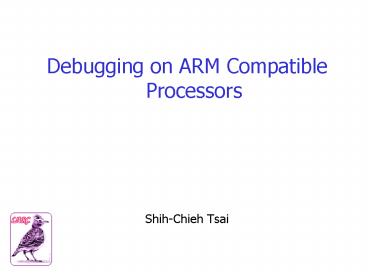Debugging on ARM Compatible Processors PowerPoint PPT Presentation
1 / 13
Title: Debugging on ARM Compatible Processors
1
- Debugging on ARM Compatible Processors
- Shih-Chieh Tsai
2
Outline
- Introduction
- Monitoring Techniques for RISC Embedded Systems
- ARMs Embedded ICE
- Future Work
3
Introduction
- With advances of microprocessor design, what we
think is not necessarily what we get. - Focus on programming errors caused by designers.
Other imperfection are not included, such as
process variation, EDA tools bugs.
4
Introduction (Contd)
- Monitoring is the extraction of information from
a computational process. - Process varies in at least 2 fields
- No. of pins.
- Time frame where measurements take place.
5
Passive vs. Active Monitoring
- Passive monitoring data is observed, collected,
and stored. - Active monitoring data can be analyzed and we
can take certain actions based on the analysis
performed.
Data Acquisition Emulation and Analysis
Target System
Host Computer
6
In-Circuit Emulators
- The most popular monitors for embedded systems.
- Help designers from software coding to HW/SW
integration and final testing. - Implemented by replacing the original processor
with a test equipment incorporating an identical
microprocessor prototype. - Basic components probes, event filter, counters,
memory circuit for buffering and control CKT. - The ICE should not interfere the system being
monitored. - Disadvantage speed limit
7
Logic Analyzers 1/2
- Passive hardware. It does not provide any control
over the targeted processor. - 2 purposes of using LA
- Analyzer the software.
- Verify data flow.
- Logic level vs. time values can be sampled at
periodic intervals. - Advantage
- Non-intrusive to SW and HW execution. Can execute
real-time monitoring. - Flexible. High speed LA can be configured for
high speed processors where channel width can be
traded for sampling speed.
8
Logic Analyzers 2/2
- Disadvantage
- Passive monitors cant perform debug functions.
- LA is usually designed to work with only one
processor.
9
ARM's Embedded ICE Solution
- Advantages
- No pin count overhead.
- Low cost.
- Debug can be performed at full processor speed.
- Processor removal is not required.
- Requires no extra communication channel to debug.
- Works on any deeply embedded ARM system.
10
Obstacles to Conquer
- High ability to observe the functionality of a
processor in an embedded system. - With clock rate exceeding 50Mhz, latching devices
may be required to obtain meaningful data.
11
System Components
12
Future Work
- Based on jhwus ARM code, implement a debugging
environment around it. - For feasibility, tap out is necessary.
- Other peripheral circuits and programs.
13
ARM7DI Core Architecture

